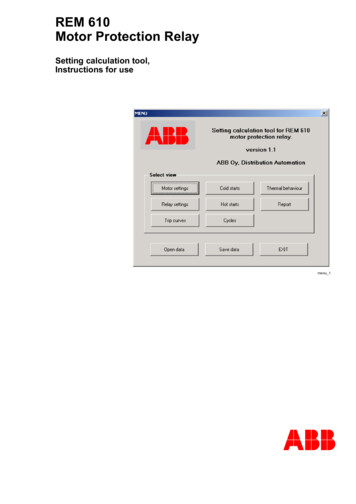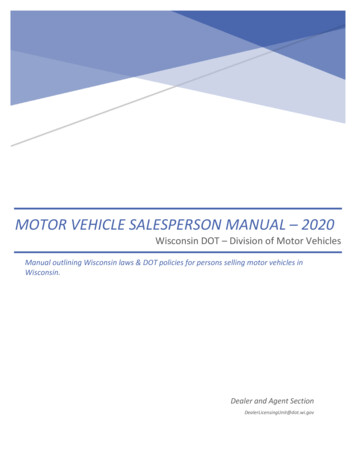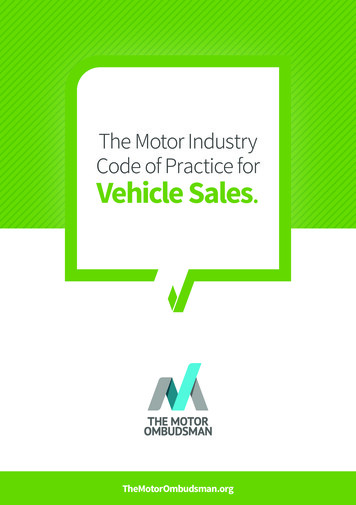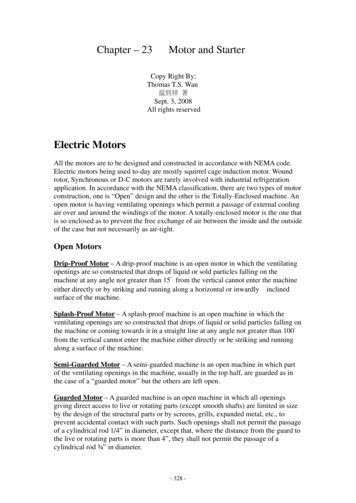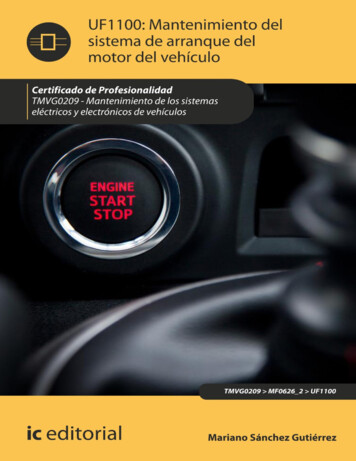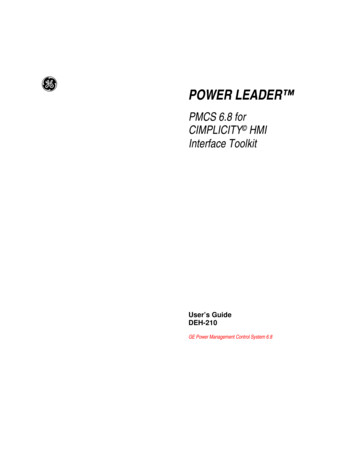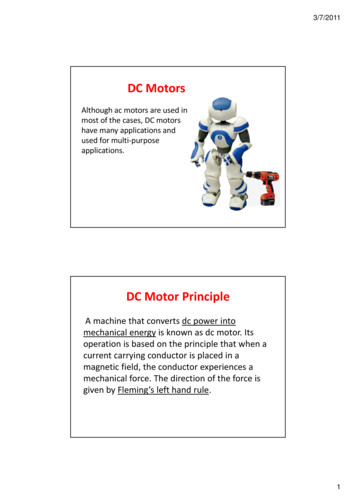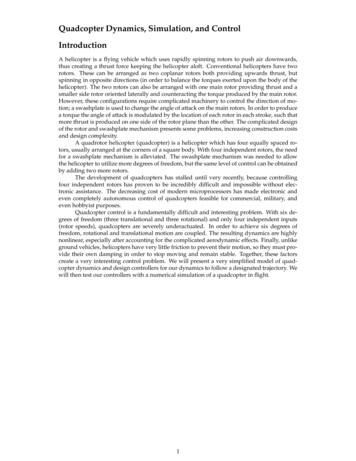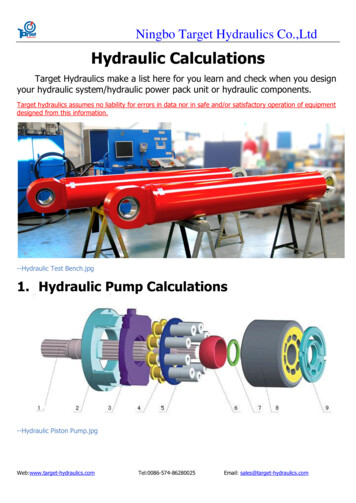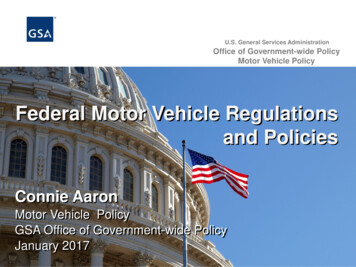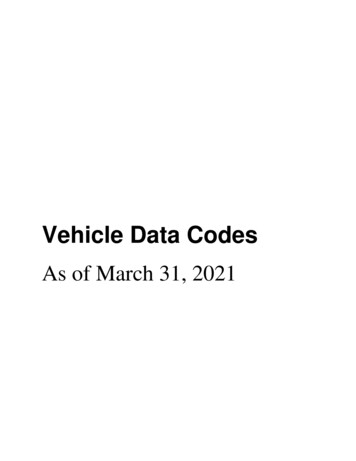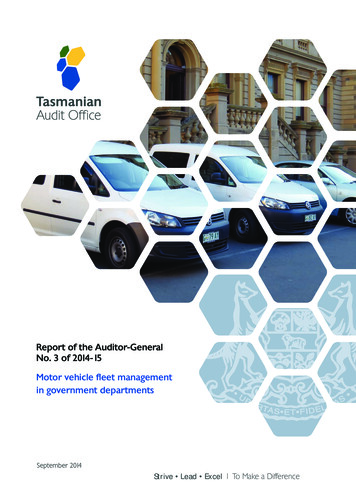
Transcription
Report of the Auditor-GeneralNo. 3 of 2014-15Motor vehicle fleet managementin government departmentsSeptember 2014Strive Lead Excel To Make a Difference
The Role of the Auditor-GeneralThe Auditor-General’s roles and responsibilities, and therefore of the Tasmanian Audit Office, are set out in theAudit Act 2008 (Audit Act).Our primary responsibility is to conduct financial or ‘attest’ audits of the annual financial reports of State entities. Stateentities are defined in the Interpretation section of the Audit Act. We also audit those elements of the Treasurer’sAnnual Financial Report reporting on financial transactions in the Public Account, the General Government Sectorand the Total State Sector.Audits of financial reports are designed to add credibility to assertions made by accountable authorities in preparingtheir financial reports, enhancing their value to end users.Following financial audits, we issue a variety of reports to State entities and we report periodically to the Parliament.We also conduct performance audits and compliance audits. Performance audits examine whether a State entityis carrying out its activities effectively and doing so economically and efficiently. Audits may cover all or part of aState entity’s operations, or consider particular issues across a number of State entities.Compliance audits are aimed at ensuring compliance by State entities with directives, regulations and appropriateinternal control procedures. Audits focus on selected systems (including information technology systems), accountbalances or projects.We can also carry out investigations but only relating to public money or to public property. In addition, theAuditor-General is now responsible for state service employer investigations.Performance and compliance audits are reported separately and at different times of the year, whereas outcomesfrom financial statement audits are included in one of the regular volumes of the Auditor-General’s reports to theParliament normally tabled in May and November each year.Where relevant, the Treasurer, a Minister or Ministers, other interested parties and accountable authorities areprovided with opportunity to comment on any matters reported. Where they choose to do so, their responses, orsummaries thereof, are detailed within the reports.The Auditor-General’s Relationship with the Parliament and State EntitiesThe Auditor-General’s role as Parliament’s auditor is tate EntitiesPublic AccountsCommitteeAuditor-GeneralIndependent and Objective
2014No. 112014PARLIAMENT OF TASMANIAREPORT OF THEAUDITOR-GENERALNo. 3 of 2014–15Motor vehicle fleet management ingovernment departmentsSeptember 2014Presented to both Houses of Parliament in accordance with the provisions of the Audit Act 2008
Crown in Right of the State of Tasmania September 2014Auditor-General’s reports are available from the Tasmanian Audit Office, Hobart,although in limited supply. This report, and other Special Reports, can beaccessed via our home page (http://www.audit.tas.gov.au).For further information please contact:Tasmanian Audit OfficeGPO Box 851HobartTASMANIA 7001Phone: (03) 6226 0100, Fax (03) 6226 0199Email: admin@audit.tas.gov.auThis report is printed on FSC Mix Paper from responsible sources.ISBN: 978-0-9925757-2-4
4 September 2014PresidentLegislative CouncilHOBARTSpeakerHouse of AssemblyHOBARTDear Mr PresidentDear Madam SpeakerREPORT OF THE AUDITOR-GENERALNo. 3 of 2014–15: Motor vehicle fleet management in government departmentsThis report has been prepared consequent to examinations conducted under section 23 of the AuditAct 2008. The objectives of the audit were to determine whether the use of Government motorvehicle fleets was effective, efficient and complied with relevant policies and guidelines.Yours sincerelyH M BlakeAUDITOR-GENERALThis page left blank intentionally
This page left blank intentionally
ContentsForeword .viiExecutive summary . 2Background . 2Background . 2Detailed audit conclusions. 3Recommendations made . 4Audit Act 2008 section 30 — Submissions and comments received . 6Introduction .101Was fleet size matched to need? .141.1Background . 141.4Were there business cases for new motor vehicles? . 171.21.321.52.22.32.42.52.62.7Conclusion . 18Background . 20Was there regular monitoring of fleet management reports? . 20Rotation of vehicles . 21Were vehicles well maintained? . 22Was fuel usage minimised?. 23Was FBT liability minimised? . 23Conclusion . 24Did fleet management comply with government policies? .263.13.23.33.43.53.64Were there bottlenecks in motor vehicle availability? . 16Were fleet costs minimised? .202.13Were there too many motor vehicles? . 143.73.8Background . 26Was the choice of vehicles compliant? . 26Did greenhouse emissions comply with guidelines? . 26Did vehicle safety standards comply? . 27Was usage subject to authorisation? . 27Were driver identification records kept? . 28Was home garaging of vehicles in accordance with policy? . 28Conclusion . 29Was there a strategic approach to fleet management? .324.14.2Background . 32Were there clear and well-promulgated policies?. 32v
4.34.44.5Was the fleet size subject to regular review? . 32Did KPIs exist to measure and motivate efficiency and effectiveness? . 33Conclusion . 34Independent auditor’s conclusion .36Recent reports .40Current projects .42LIST OF TABLESTable 1: Potentially under used motor vehicles*. 14Table 2: Examples of monitoring exception reports at DPIPWE . 21Table 3: Standard deviations of G-plated fleets . 22Table 4: Fuel use compared to manufacturer’s standards . 23vi
ForewordTasmanian government departments use a fleet of approximately 2 500 lightpassenger and commercial vehicles recorded on the balance sheet of FinanceGeneral at about 60m. This is a significant asset in the Tasmanian context. It is,therefore, essential that these vehicles are used efficiently and effectively theassessment of which were the first two components of this audit.To assure efficiency and effectiveness, departments are required to comply withadministrative policy on allocation and usage and with established fleetmanagement arrangements. As a result, assessing compliance was the thirdcomponent of our work.Our audit also had regard to the former Premier’s 2011 requirement thatgovernment departments reduce fleet costs with our expectation that, by thetime of our audit, work would already have been done to rationalise motorvehicle numbers and costs.While I concluded that motor vehicle fleets were being managed effectively,efficiently and in compliance with policies, I noted opportunities forimprovement by varying fleet sizes, paying greater attention to exceptionreports, improving fuel usage and developing a more strategic approach tomanaging the fleet. Where relevant, the four departments involved in this auditare encouraged to implement related recommendations.Departments, and other State entities, not selected for audit may also find thisReport and its recommendations of benefit in ensuring they manage their vehiclefleets appropriately.My thanks to all staff involved on this audit in particular those from the fourdepartments we audited.This audit will form the basis for a second audit of fleet management andassociated functions planned for the next 12 months at Police, the State FireService and selected non-general government sector entities.H M BlakeAuditor-General4 September 2014vii
This page left blank intentionally
Executive summaryMotor vehicle fleet managementin government departments1
Executive summaryExecutive summaryBackgroundBackgroundTasmanian government departments use a fleet ofapproximately 2 500 light passenger and commercial vehicles.Government vehicles allocated for work-related purposes arethe same as any other asset used to provide goods and servicesto the public. Their use is subject to considerations of efficiency,effectiveness and economy— as well as to appropriatestandards of probity and accountability. Policy on motorvehicles is provided by two central government departments.First is the Department of Premier and Cabinet (DPAC) thatdevelops administrative policy on allocation and usage, much ofwhich is contained in its Policy and guidelines for the allocationand use of Tasmanian Government motor vehicles — Departmentof Premier and Cabinet. That policy is an overarching documentand DPAC expects that departments should develop their ownbusiness-specific internal procedures within that policyframework.The other is the Department of Treasury and Finance(Treasury), which is responsible for managing the leasingcontract (acquisition and disposals) and fleet managementarrangements. Treasury requirements are contained in theGovernment vehicle fleet management: fleet managementhandbook — Department of Treasury and Finance.Under current arrangements, rather than purchasing,government leases motor vehicles from a vehicle fleet provider,namely LeasePlan Australia Limited (LeasePlan). As part of itsrole, LeasePlan provides detailed motor vehicle reporting toenable departmental fleet managers to effectively control theirrespective fleets.The objective of the audit was to determine whether the use ofGovernment motor vehicle fleets was effective, efficient andcomplied with relevant policies and guidelines. We focused onselected government departments, namely: Premier and Cabinet — including the ministerial fleet— (DPAC)Justice (DoJ)2Motor vehicle fleet managementin government departments
Executive summary Economic Development, Tourism and the Arts(DEDTA 1)Primary Industries, Parks, Water and Environment(DPIPWE).The audit concentrated on a two-year period that foroperational matters covered the financial years 1 July 2011 to30 June 2013.Detailed audit conclusionsThe audit conclusions are based on criteria that we developed tosupport the audit’s objective and are aligned to the chapterstructure of the Report.Was fleet size matched to need?All departments had at least a reasonable match between fleetsize and need and most had processes to assess whether needexisted before leasing a new vehicle. However, there appearedto be scope for fleet reductions at DEDTA and DoJ and possibleadditions at DPIPWE.Were fleet costs minimised?We found evidence that maintenance costs and FBT liabilitieswere being minimised. However, there was scope to improvemonitoring of fleet exception reports that could yield furthereconomies. Also, fuel use of DPAC’s fleet could possibly bereduced.Did fleet management comply with government policies?We found substantial compliance with government policies. Nodiscrepancies were noted in respect of choice of motor vehicle,meeting of safety and greenhouse emission standards. We alsofound reasonable compliance in the areas of authorisation ofuse, identification of drivers and home garaging. One area ofinfrequent shortcomings was location and completeness of logbooks.Was there a strategic approach to fleet management?In no department was there persuasive evidence of a strategicapproach to fleet management. While all departments hadpolicies, KPIs had not been developed and regular reviews offleet size were not performed.1DEDTA was merged into the new Department of State Growth from 1 July 2014.Throughout the report, we refer to the previous Department of Economic Development,Tourism and the Arts.Motor vehicle fleet managementin government departments3
Executive summaryRecommendations madeRec12Section1.21.3The Report contains the following recommendations:Applies toDEDTA,DoJDPIPWEWe recommend that DEDTA and DoJ consider reductions in motorvehicle numbers. DPIPWE investigates whether: J104.3All124.4All6112.54.3AllDPACAllit can use its fleet more efficientlyadditions to its fleet might allow forreductions in external hire, sufficient to leadto net savings. departments provide a zero-based rationale forany new G-plate vehicle, including where the leasedvehicle is to replace an existing vehicle. departments effectively monitor anomaliesflagged in fleet usage and exception reports. departments more effectively rotate motorvehicles to ensure more even use of vehicles. departments ensure that driver training isprovided where necessary to improve the fuelefficiency of its motor vehicle fleet. departments introduce mechanisms such astraining and spot checks to ensure logbooks for Gplated motor vehicle are complete and accurate. departments ensure that motor vehicle logbooksare properly stored to ensure they are retrievable atshort notice. procedures for authorisation and booking of carsbe included in departmental fleet usageinstructions. departments conduct regular zero-based reviewsof fleet size in accordance with DPAC guidelines. departments consider introduction ofarrangements for sharing of fleet cars with otherGovernment departments to enable reductions inthe size of department fleets. departments develop fleet management KPIs todrive improved efficiency.4Motor vehicle fleet managementin government departments
Audit Act 2008 section 30 — Submissions and comments receivedMotor vehicle fleet managementin government departments5
Audit Act 2008 section 30 — Submissions and comments receivedAudit Act 2008 section 30 — Submissions and commentsreceivedIntroductionIn accordance with section 30(2) of the Audit Act 2008, a copy ofthis Report was provided to the state entities indicated in theIntroduction to this Report.A summary of findings, with a request for submissions orcomments, was also provided to the relevant portfolio Ministersand the Treasurer.Submissions and comments that we receive are not subject tothe audit nor the evidentiary standards required in reaching anaudit conclusion. Responsibility for the accuracy, fairness andbalance of these comments rests solely with those who providedthe response. However, views expressed by agencies wereconsidered in reaching audit conclusions.Section 30(3) of the Act requires that this Report include anysubmissions or comments made under section 30(2) or a fairsummary of them. Submissions received are included fromAgency heads in full below.Former Department of Economic Development, Tourismand the Arts (now part of Department of State Growth)Thank you for the opportunity for the former Department ofEconomic Development, Tourism and the Arts (DEDTA) toparticipate in the Motor vehicle fleet management ingovernment departments audit.As you would be aware from 1 July 2014, DEDTA and theDepartment of Infrastructure, Energy and Resources (DIER)transitioned to the Department of State Growth.A review of the former DEDTA’s, DIER’s and Skills Tasmaniafleet practices is underway with the aim of creating furtheroperational efficiencies, ensuring the vehicle fleet is fit forpurpose and minimising vehicle expenses. The former DIER andDEDTA fleet operations have seen significant fleet reductions ofrecent times and have adopted a number of practices thatsupport the recommendations in the audit report. Otherrecommendations that are not, or only in part, implemented in6Motor vehicle fleet managementin government departments
Audit Act 2008 section 30 — Submissions and comments receivedconjunction with the review, will be a valuable tool indeveloping fleet management policies and practices into thefuture.Kim EvansActing SecretaryDepartment of JusticeThe Department of Justice welcomes the audit of its vehicle fleetand acknowledges the overall findings. I am pleased to advisethat, at the time of audit, the Department was already in theprocess of actioning a number of initiatives to further reduce thesize of its fleet, including: the construction of a secure carparking facility at the Department’s Rosny premises to removethe need to home garage vehicles for security purposes, and apilot project to develop a car pooling system within the HobartCBD incorporating various Departmental sites.However, it should be noted that the Department has a numberof vehicles which have a high usage, which isn’t reflected by thenumber of kilometres completed. A number of vehicles may bein use all day (supervising prisoners or inspecting worksites),without being driven all day.Also, the Department has a number of vehicles fitted out forspecific uses, including transport of: drug detector dogs,prisoners with babies, specialist equipment and other largercapacity vehicles which are not to be used as pool cars to ensurethey are available as and when required. The Department isalso spread throughout various sites across Hobart andthroughout the State, so in many cases it cannot utiliseeconomies of scale with regard to pooling the use of its vehicles.The Department will incorporate the review recommendationsas far as is possible within its operational requirements andstructure.Simon OverlandSecretaryDepartment of Primary Industry, Parks, Water andEnvironmentThis Department welcomed the opportunity to participate inwhat was an extensive audit, designed to highlight opportunitiesfor greater efficiency in the management, maintenance andgeneral operation of the Government’s motor vehicle fleet.Motor vehicle fleet managementin government departments7
Audit Act 2008 section 30 — Submissions and comments receivedThe department is committed to a process of continuousimprovement in the management of its vehicle resources andconsideration of the key recommendations contained in thisreport will be important in achieving this outcome.John WhittingtonActing Secretary8Motor vehicle fleet managementin government departments
IntroductionMotor vehicle fleet managementin government departments9
IntroductionIntroductionBackgroundTasmanian government departments use a fleet ofapproximately 2 500 light passenger and commercial vehicles.Government vehicles allocated for work-related purposes arethe same as any other asset used to provide goods and servicesto the public. Their use is subject to considerations of efficiency,effectiveness and economy — as well as to appropriatestandards of probity and accountability. Policy on motorvehicles is provided by two central government departments.First is the Department of Premier and Cabinet (DPAC) thatdevelops administrative policy on allocation and usage, much ofwhich is contained in its Policy and guidelines for the allocationand use of Tasmanian Government motor vehicles — Departmentof Premier and Cabinet. That policy is an overarching documentand DPAC expects that departments should develop their ownbusiness-specific internal procedures within that policyframework.The other is the Department of Treasury and Finance(Treasury), which is responsible for managing the leasingcontract (i.e. acquisition and disposals) and fleet managementarrangements. Treasury requirements are contained in theGovernment vehicle fleet management: fleet managementhandbook — Department of Treasury and Finance.Under current arrangements, rather than purchasing,government leases motor vehicles from a vehicle fleet provider,namely LeasePlan Australia Limited (LeasePlan). As part of itsrole, LeasePlan provides detailed motor vehicle reporting toenable departmental fleet managers to effectively control theirrespective fleets.In 2011, the Premier required government departments toreduce fleet costs and Treasury issued whole-of-governmentinitiatives to ensure that those savings were achieved. In thatcontext, our expectation was that work would already have beendone to rationalise motor vehicle numbers and costs.Audit objectiveThe objectives of the audit were to determine whether the use ofGovernment motor vehicle fleets was effective, efficient andcompliant with relevant policies and guidelines.10Motor vehicle fleet managementin government departments
IntroductionAudit scopeThe audit focused on selected government departments,namely: Premier and Cabinet — including the ministerial fleet— (DPAC)Justice (DoJ)Economic Development, Tourism and the Arts(DEDTA 2)Primary Industries, Parks, Water and Environment(DPIPWE).The audit concentrated on a two-year period that foroperational matters covered the financial years 1 July 2011 to30 June 2013.For fringe benefit tax (FBT) reporting, the audit’s scope wasfrom 1 April 2011 to 31 March 2013 (i.e. two FBT reportingyears).Audit criteriaWe developed a number of audit criteria, namely: Was there a match between fleet size and need?Were fleet costs minimised?Was fleet management compliant with Treasury andDPAC requirements?Were there clear and effectively promulgated policiesand procedures?Did KPIs and related targets exist for efficiency andeffectiveness?Was there regular monitoring of fleet managementreports?Was FBT minimised?Format of the reportTo make the report more useful for readers, we amalgamatedsome of the above audit criteria into logical groupings. This isreflected in the chapter structure that we used:DEDTA was merged into the new Department of State Growth from 1 July 2014.Throughout the report, we refer to the previous Department of Economic Development,Tourism and the Arts.2Motor vehicle fleet managementin government departments11
IntroductionChapter 1Was fleet size matched to need?Chapter 3Did fleet management comply withgovernment policies?Chapter 2Chapter 4Were fleet costs minimised?Audit approachWas there a strategic approach to fleetmanagement?In line with the preceding audit criteria, we sought appropriateaudit evidence through: Timingreviewing fleet manager’s recordsexamining motor vehicle log booksreviewing business caseschecking policies and guidelinesinterviewing staff.Planning for this audit began in September 2013 with fieldworkcontinuing until June 2014. The report was finalised in August2014.ResourcesThe audit plan recommended 1 000 hours and a budget,excluding production costs, of 151 964. Total hours were 1340and actual costs, excluding production, were 206 800 whichexceeded our budget.Why this project was selectedThis audit was included in the Annual Plan of Work 2012–13because significant state funds are tied up in the fleet and inmeeting day-to-day running costs.12Motor vehicle fleet managementin government departments
1 Was fleet size matched to need?Motor vehicle fleet managementin government departments13
Chapter 1 — Was fleet size matched to need?1 Was fleet size matched to need?1.1BackgroundThe number and type of vehicles in a fleet should align withbusiness needs. Surplus vehicles will generate excessive fleetcosts while too few can lead to excess hire or operational needsnot being met.We examined whether departments had: 1.2too many motor vehiclesbottlenecks in motor vehicle availabilitybusiness cases for new (including replacement)motor vehicles.Were there too many motor vehicles?In Tasmania, LeasePlan’s exception reports identify vehiclestravelling less than 15 000 km per year as potentially underused. Specific-use vehicles or vehicles in particular locations canbe an exception to this benchmark where the vehicle is essentialregardless of its annual usage. No equivalent benchmark existedfor high usage. However, excessive usage could lead to increaseduse of externally sourced motor vehicles to offset nonavailability of fleet units.We tested motor vehicle usage against the 15 000 annualkilometre benchmark.Table 1: Potentially under used motor vehicles*DepartmentNo ofeligibleMV 15 000km pa 15 000km pa(%)Averageannualkm**DEDTA24521%18 835DPAC13215%35 595DoJDPIPWEAverage6423158182594836%11%19%18 62622 98422 155(weighted)* To be eligible for this audit test, motor vehicles needed to be: G-plated or part of the ministerial fleet purchased prior to 1 January 2013 still in service at 30 June 2013.14Motor vehicle fleet managementin government departments
Chapter 1 — Was fleet size matched to need?There appeared to be significant under use at all departmentsbased on motor vehicles with less than 15 000 annualkilometres. During testing at DPIPWE, we noted that most of thelow-use motor vehicles were specialised and were needed intheir specific assignments regardless of the annual kilometrestravelled 3.We also tested the log books of 40 motor vehicles across thefour departments and noted significant percentages of ‘businessuse’ were actually commuting kilometres, that is, travel betweenwork and home. If those commute percentages were netted offevenly across the respective fleets, the number of under usedmotor vehicles would be 65 rather than 48 (or 25 per cent).In addition, we looked at average annual kilometres. Thestandard LeasePlan contract is for 3 years or 60,000 km and weconcluded that 20 000 km was a reasonable annual average. Ofthe departments audited, only DoJ and DEDTA were below thattarget.Looking at the agencies individually, we concluded as follows.DEDTAWith an average usage below 20 000 km (18 835) and 21 percent of motor vehicles less than 15 000 km, it was fairly likelythat there was scope to reduce the size of the fleet.DoJWith an average usage below 20 000 km (18 626) and 36 percent of motor vehicles less than 15 000 km, it was probable thatthere was scope to reduce the size of the fleet.DPACWith an average usage well above 20 000 km (35 595) and onlytwo motor vehicles less than 15 000 km, there was little scope toreduce the size of the fleet.DPIPWEWith an average usage above 20 000 km (22 984) and 11 percent of motor vehicles less than 15 000 km — many of whichwere specialist units —there was little scope to reduce the sizeof the fleet.3Examples of specialised vehicles include fire trucks and off-road vehicles.Motor vehicle fleet managementin government departments15
Chapter 1 — Was fleet size matched to need?Recommendation 1 (DEDTA and DoJ)We recommend that DEDTA and DoJ consider reductions inmotor vehicle numbers.1.3Were there bottlenecks in motor vehicle availability?To determine whether bottlenecks existed, we reviewed annualkilometres travelled by motor vehicles and tested for excessiveuse of external hire (including taxis) and employees’ own motorvehicles.DEDTAWe found that: Average kilometres was a comfortable 18 835 for Gplates, with only four doing more than 25 000annually. Annual cost of external hire was approximately 12 000; similar to the cost of one additional motorvehicle. This was low compared to otherdepartments audited.We concluded that DEDTA did not have significant bottlenecksin motor vehicle availability.DoJWe found that the annual cost of external hire wasapproximately 144 000; a high figure compared to DEDTA andDPAC.However, we accepted DoJ’s arguments that the comparison wasnot valid because it performed operations throug
books. Was there a strategic approach to fleet management? In no department was there persuasive evidence of a strategic approach to fleet management. While all departments had policies, KPIs had not been developed and regular reviews of fleet size were not performed. 1. DEDTA was merged
